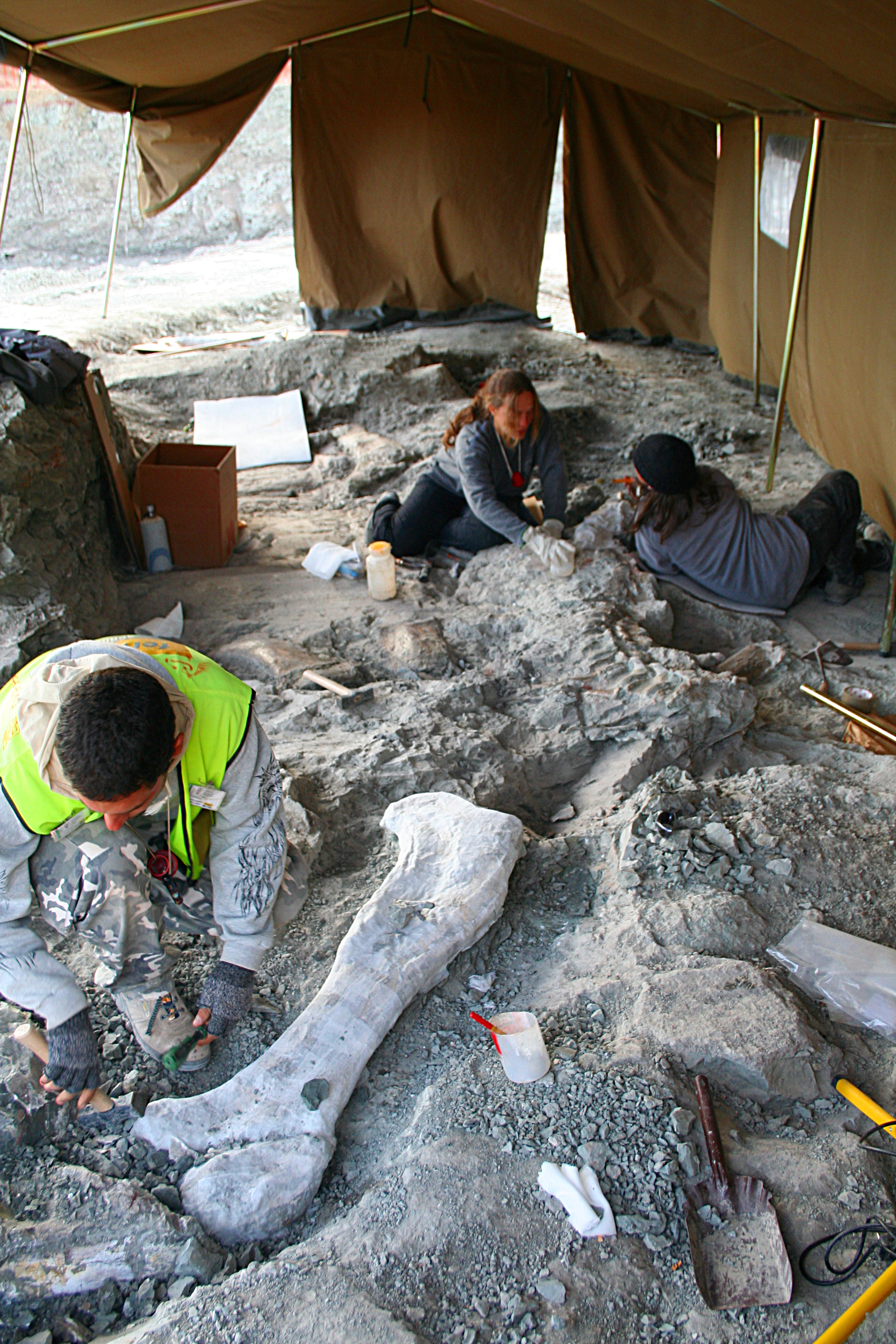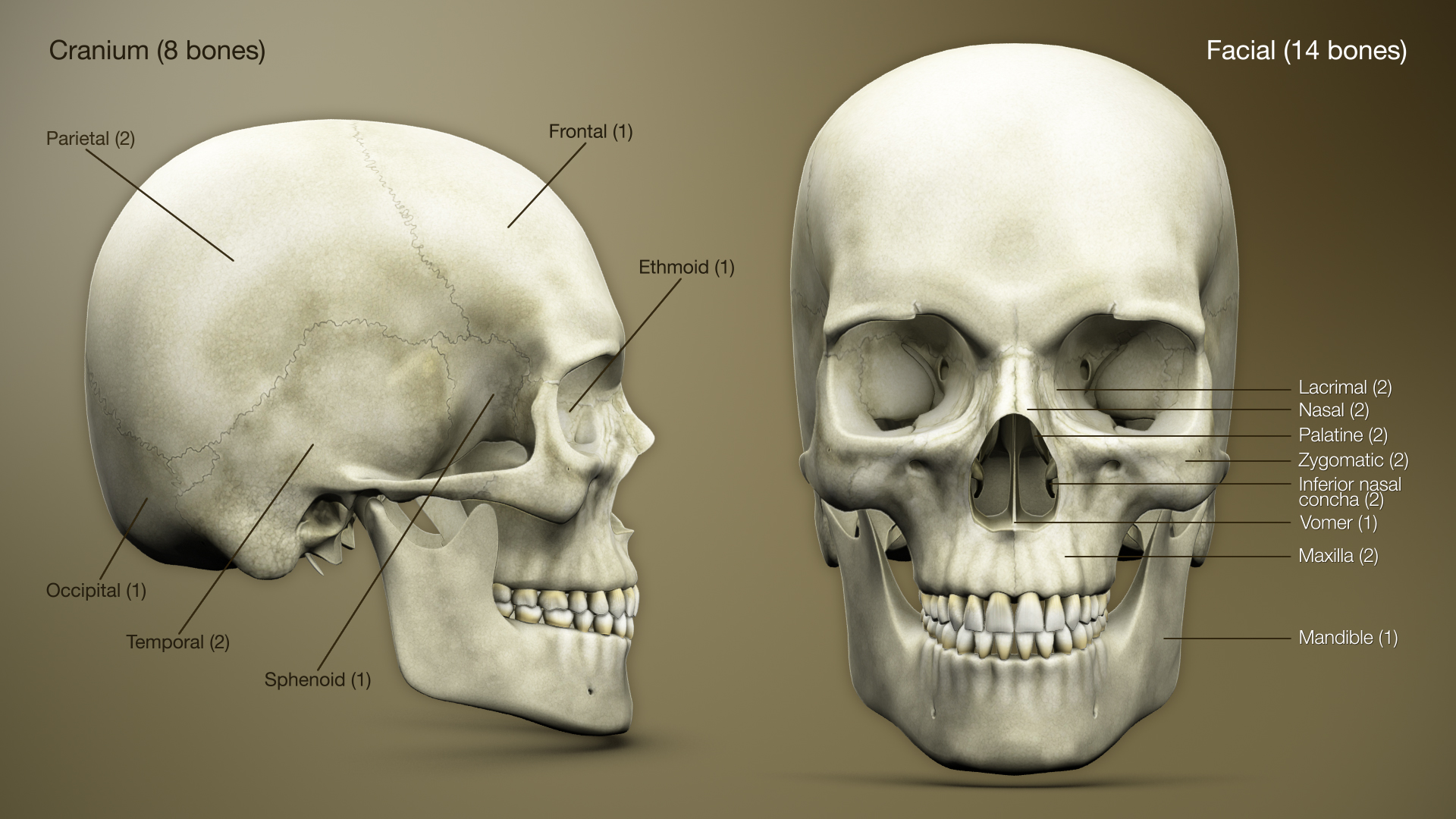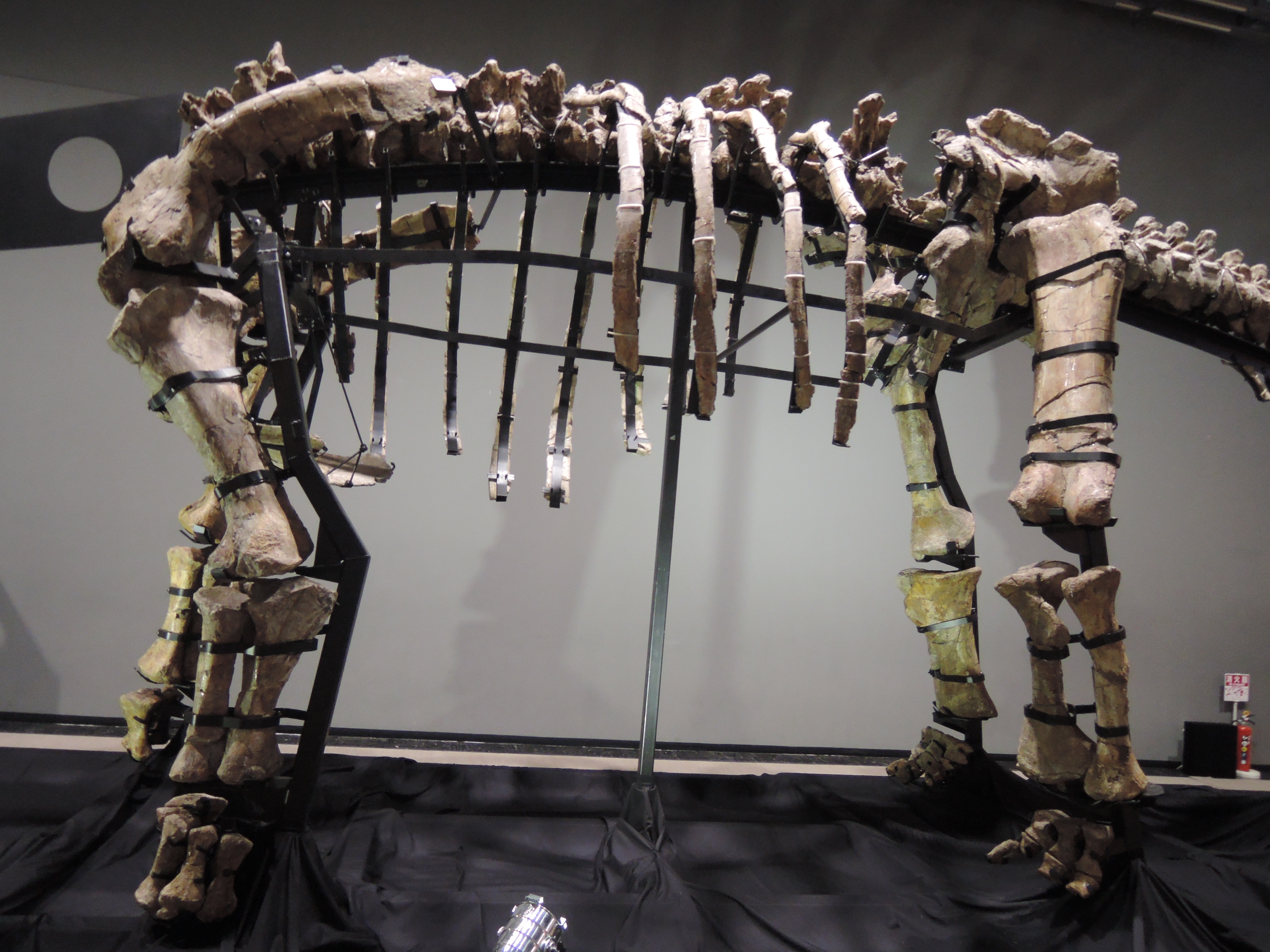|
Post-cranial
The postcranium ("behind the cranium"; plural: postcrania) or postcranial skeleton in zoology and vertebrate paleontology is the skeleton apart from the skull. The postcranium encompasses the axial skeleton, which includes the entirety of the vertebrae and ribs, and the appendicular skeleton The appendicular skeleton is the portion of the vertebrate endoskeleton consisting of the bones, cartilages and ligaments that support the paired appendages ( fins, flippers or limbs). In most terrestrial vertebrates (except snakes, legless li ..., which includes girdles and limbs. In paleontology, there may be disagreement over whether the skull and skeleton belong to the same or different animals. One example is the case of the dinosaur '' Nemegtosaurus'', which is known only from a skull that was found in the same geological formation as the related '' Opisthocoelicaudia'', which is only known from postcranial material. References Skeletal system {{Vertebrate anatomy-stub ... [...More Info...] [...Related Items...] OR: [Wikipedia] [Google] [Baidu] |
Cranium
The skull, or cranium, is typically a bony enclosure around the brain of a vertebrate. In some fish, and amphibians, the skull is of cartilage. The skull is at the head end of the vertebrate. In the human, the skull comprises two prominent parts: the neurocranium and the facial skeleton, which evolved from the first pharyngeal arch. The skull forms the frontmost portion of the axial skeleton and is a product of cephalization and vesicular enlargement of the brain, with several special senses structures such as the eyes, ears, nose, tongue and, in fish, specialized tactile organs such as barbels near the mouth. The skull is composed of three types of bone: cranial bones, facial bones and ossicles, which is made up of a number of fused flat and irregular bones. The cranial bones are joined at firm fibrous junctions called sutures and contains many foramina, fossae, processes, and sinuses. In zoology, the openings in the skull are called fenestrae, the most p ... [...More Info...] [...Related Items...] OR: [Wikipedia] [Google] [Baidu] |
Zoology
Zoology ( , ) is the scientific study of animals. Its studies include the anatomy, structure, embryology, Biological classification, classification, Ethology, habits, and distribution of all animals, both living and extinction, extinct, and how they interact with their ecosystems. Zoology is one of the primary branches of biology. The term is derived from Ancient Greek , ('animal'), and , ('knowledge', 'study'). Although humans have always been interested in the natural history of the animals they saw around them, and used this knowledge to domesticate certain species, the formal study of zoology can be said to have originated with Aristotle. He viewed animals as living organisms, studied their structure and development, and considered their adaptations to their surroundings and the function of their parts. Modern zoology has its origins during the Renaissance and early modern period, with Carl Linnaeus, Antonie van Leeuwenhoek, Robert Hooke, Charles Darwin, Gregor Mendel a ... [...More Info...] [...Related Items...] OR: [Wikipedia] [Google] [Baidu] |
Vertebrate Paleontology
Vertebrate paleontology is the subfield of paleontology that seeks to discover, through the study of fossilized remains, the behavior, reproduction and appearance of extinct vertebrates (animals with vertebrae and their descendants). It also tries to connect, by using the evolutionary timeline, the animals of the past and their modern-day relatives. The fossil record shows aspects of the meandering evolutionary path from early aquatic vertebrates to modern fish as well as mammals, birds, reptiles and amphibians, with a host of transitional fossils, though there are still large blank areas. The earliest known fossil vertebrates were heavily armored fish discovered in rocks from the Ordovician period about 485 to 444 Ma ( megaannum, million years ago), with jawed vertebrates emerging in the following Silurian period (444 to 419 Ma) with the placoderms and acanthodians. The Devonian period (419 to 359 Ma) saw primitive air-breathing fish to develop limbs allowing ... [...More Info...] [...Related Items...] OR: [Wikipedia] [Google] [Baidu] |
Skeleton
A skeleton is the structural frame that supports the body of most animals. There are several types of skeletons, including the exoskeleton, which is a rigid outer shell that holds up an organism's shape; the endoskeleton, a rigid internal frame to which the organs and soft tissues attach; and the hydroskeleton, a flexible internal structure supported by the hydrostatic pressure of body fluids. Vertebrates are animals with an endoskeleton centered around an axial vertebral column, and their skeletons are typically composed of bones and cartilages. Invertebrates are other animals that lack a vertebral column, and their skeletons vary, including hard-shelled exoskeleton (arthropods and most molluscs), plated internal shells (e.g. cuttlebones in some cephalopods) or rods (e.g. ossicles in echinoderms), hydrostatically supported body cavities (most), and spicules (sponges). Cartilage is a rigid connective tissue that is found in the skeletal systems of vertebrates and invert ... [...More Info...] [...Related Items...] OR: [Wikipedia] [Google] [Baidu] |
Skull
The skull, or cranium, is typically a bony enclosure around the brain of a vertebrate. In some fish, and amphibians, the skull is of cartilage. The skull is at the head end of the vertebrate. In the human, the skull comprises two prominent parts: the neurocranium and the facial skeleton, which evolved from the first pharyngeal arch. The skull forms the frontmost portion of the axial skeleton and is a product of cephalization and vesicular enlargement of the brain, with several special senses structures such as the eyes, ears, nose, tongue and, in fish, specialized tactile organs such as barbels near the mouth. The skull is composed of three types of bone: cranial bones, facial bones and ossicles, which is made up of a number of fused flat and irregular bones. The cranial bones are joined at firm fibrous junctions called sutures and contains many foramina, fossae, processes, and sinuses. In zoology, the openings in the skull are called fenestrae, the most ... [...More Info...] [...Related Items...] OR: [Wikipedia] [Google] [Baidu] |
Axial Skeleton
The axial skeleton is the core part of the endoskeleton made of the bones of the head and trunk of vertebrates. In the human skeleton, it consists of 80 bones and is composed of the skull (28 bones, including the cranium, mandible and the middle ear ossicles), the vertebral column (26 bones, including vertebrae, sacrum and coccyx), the rib cage (25 bones, including ribs and sternum), and the hyoid bone. The axial skeleton is joined to the appendicular skeleton (which support the limbs) via the shoulder girdles and the pelvis. Structure Flat bones house the brain and other vital organs. This article mainly deals with the axial skeletons of humans; however, it is important to understand its evolutionary lineage. The human axial skeleton consists of 81 different bones forming the medial core of the body and connects the pelvis to the body, where the appendicular skeleton attaches. As the skeleton grows older the bones get weaker with the exception of the skull. The skull ... [...More Info...] [...Related Items...] OR: [Wikipedia] [Google] [Baidu] |
Appendicular Skeleton
The appendicular skeleton is the portion of the vertebrate endoskeleton consisting of the bones, cartilages and ligaments that support the paired appendages ( fins, flippers or limbs). In most terrestrial vertebrates (except snakes, legless lizards and caecillians), the appendicular skeleton and the associated skeletal muscles are the predominant locomotive structures. There are 126 bones in the human appendicular skeleton, includes the skeletal elements within the shoulder and pelvic girdles, upper and lower limbs, and hands and feet. These bones have shared ancestry (are homologous) to those in the forelimbs and hindlimbs of all other tetrapods, which are in turn homologous to the pectoral and pelvic fins in fish. Etymology The adjective "appendicular" comes from Latin ''appendicula'', meaning "small addition". It is the diminutive of ''appendix'', which comes from the prefix ''ad-'' (meaning "to") + and the word root ''pendere'' (meaning "to hang", from PIE root ''* ... [...More Info...] [...Related Items...] OR: [Wikipedia] [Google] [Baidu] |
Nemegtosaurus
''Nemegtosaurus'' (meaning 'Reptile from the Nemegt') was a sauropod dinosaur from the Late Cretaceous Period of what is now Mongolia. Measuring an estimated long and weighing , it was named after the Nemegt Basin in the Gobi Desert, where the remains — a single skull — were found. The skull resembles diplodocoids in being long and low, with pencil-shaped teeth. However, recent work has shown that ''Nemegtosaurus'' is in fact a titanosaur, closely related to animals such as ''Saltasaurus'', '' Alamosaurus'' and '' Rapetosaurus''. Discovery and taxonomy The skull of ''Nemegtosaurus'' comes from the same beds as the titanosaur '' Opisthocoelicaudia'', which is known from a skeleton lacking the neck and skull. Originally, the referral of ''Nemegtosaurus'' to Diplodocoidea and ''Opisthocoelicaudia'' to Camarasauridae argued that the two represented different species. Both of these genera represent advanced titanosaurians, however, raising the possibility that the two are in fa ... [...More Info...] [...Related Items...] OR: [Wikipedia] [Google] [Baidu] |
Formation (geology)
A geological formation, or simply formation, is a body of rock having a consistent set of physical characteristics ( lithology) that distinguishes it from adjacent bodies of rock, and which occupies a particular position in the layers of rock exposed in a geographical region (the stratigraphic column). It is the fundamental unit of lithostratigraphy, the study of strata or rock layers. A formation must be large enough that it can be mapped at the surface or traced in the subsurface. Formations are otherwise not defined by the thickness of their rock strata, which can vary widely. They are usually, but not universally, tabular in form. They may consist of a single lithology (rock type), or of alternating beds of two or more lithologies, or even a heterogeneous mixture of lithologies, so long as this distinguishes them from adjacent bodies of rock. The concept of a geologic formation goes back to the beginnings of modern scientific geology. The term was used by Abraham Gottlob ... [...More Info...] [...Related Items...] OR: [Wikipedia] [Google] [Baidu] |
Opisthocoelicaudia
''Opisthocoelicaudia'' is a genus of sauropod dinosaur of the Late Cretaceous Period discovered in the Gobi Desert of Mongolia. The type species is ''Opisthocoelicaudia skarzynskii''. A well-preserved skeleton lacking only the head and neck was unearthed in 1965 by Polish and Mongolian scientists, making ''Opisthocoelicaudia'' one of the best known sauropods from the Late Cretaceous. Tooth marks on this skeleton indicate that large carnivorous dinosaurs had fed on the carcass and possibly had carried away the now-missing parts. To date, only two additional, much less complete specimens are known, including part of a shoulder and a fragmentary tail. A relatively small sauropod, ''Opisthocoelicaudia'' measured about in length. Like other sauropods, it would have been characterised by a small head sitting on a very long neck and a barrel shaped trunk carried by four column-like legs. The name ''Opisthocoelicaudia'' means "posterior cavity tail", alluding to the unusual, opisthoco ... [...More Info...] [...Related Items...] OR: [Wikipedia] [Google] [Baidu] |








